42ND ANNUAL CONFERENCE, Buenos Aires, Argentina, 17-21 March 2003WP No. 85ADS-B OperationsPresented by SC1 |
Introduction
1.1. The continuing development of the ATM system has been driven by such factors as safety, capacity, cost, and efficiency. A further factor is the rising expectations of the ATM service user. To meet these challenges, ICAO published the “Global Air Navigation Plan for CNS/ATM Systems’ in 1996 followed by the establishment of the ICAO Air Traffic Management Concept Panel (ATMCP). The task of ATMCP is to develop “gate-to-gate ATM operational concept that will facilitate the evolutionary implementation of a seamless global ATM system”.
1.2. To support the future air traffic management system concept, a number of emerging CNS functions are being implemented. In particular, the introduction of air-ground data links, together with accurate and reliable aircraft navigation systems, which provides the opportunity to extend surveillance into non-radar coverage areas. This function is known as Automatic Dependent Surveillance (ADS) which allows aircraft to transmit data automatically to indicate position plus additional information such as intent.
1.3. IFATCA has developed policy on ADS-C but has not considered the situation when ADS reports have been broadcast (ADS-B) so that other aircraft are able to receive and display theses reports. ADS-B is regarded as the key enabling technology for future surveillance requirements.
1.4. The objective of this paper is to provide a brief overview of ADS-B with the intention of developing IFATCA policy.
Discussion
2.1 ADS-B Concept (Draft ADS-B Manual)
ADS-B is a function on an aircraft or a surface vehicle operating within the surface movement area that periodically broadcasts its state vector (horizontal and vertical position, horizontal and vertical velocity) and other information. ADS-B is automatic because no external stimulus is required to elicit a transmission; it is dependent because it relies on on-board navigation sources and on-board broadcast transmission systems to provide surveillance information to other users. The aircraft or vehicle originating the broadcast may or may not have knowledge of which users are receiving its broadcast; any user, either aircraft or ground-based, within range of this broadcast, may choose to receive and process ADS-B surveillance information. ADS-B supports improved use of airspace, reduced ceiling/visibility restrictions, improved surface surveillance, and enhanced safety such as conflict management.
2.2. It should also be noted that ADS-B is inherently different from the addressed form of ADS (ADS-C). ADS-C is based on a negotiated one-to-one peer relationship between an aircraft providing ADS information and a ground facility requiring receipt of the ADS reports.
2.3 ADS-B is the only ATS data-link application considered by OPLINKP, which permits air-to-air notification of aircraft position information without re-transmission, by a ground facility. ADS-B is not restricted to aircraft and can be used on ground vehicles and even ground obstacles.
2.4 Each ADS-B capable aircraft or ground vehicle will periodically broadcast its identity, its position and other required data provided by the onboard navigation equipment. Any user, either airborne or ground-based, within range of this broadcast may choose to receive and process this information. The aircraft or vehicle originating the broadcast need have no knowledge of what system(s) is receiving its broadcast.
2.5 Although not inherent to ADS-B operations, it is usually assumed that aircraft position will be determined on board using GPS or GNSS.
2.6. Selection of Data-Link for ADS-B
One of the obstacles to developing ADS-B has been the lack of decision about which data-link is to be used. The three candidates are: 1090 MHz Extended Squitter, VDL Mode 4 Data Link, and Universal Access Transceiver. It is not intended to discuss the pros and cons of these links however the following table indicates the fundamental characteristics of each link:
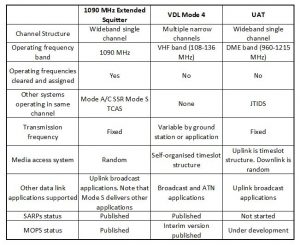
2.7 To support a decision in favour of a single data link for ADS-B, EUROCONTROL and the FAA established a group called the Technical Link Assessment Team (TLAT). It consisted of a joint team of specialists from both Europe and the US, assessing the three candidate ADS-B data links against an agreed set of traffic scenarios including the most dense traffic situations in the USA and Europe projected until 2020. The objective of TLAT was not to make a decision on the link but to gather information on the performance of the candidate data links through analysis, simulations, and trials. TLAT published the results in the summer of 2001 that indicated that no single data link meets all of the requirements. However, EUROCONTROL work has indicated a number of benefits when using a fully duplicated ADS-B data link consisting of 1090 ES and VDL-4. A combined use of these two technologies can, therefore, under certain conditions, provide a better overall performance than each of the technologies separately. Currently work continues in the areas where no information was available (surface movement), multi-link options, and enhancing performance of the data links.
2.8 As a result, EUROCONTROL has published a position paper which recommends 1090 ES as the ADS-B link for the initial implementation but also recognises that another link, possibly VDL M4, will be required in the future. It is significant to note that many of the European trials are using VDL M4. The US position is slightly different in that it recommends 1090ES for air transport aircraft and UAT for General Aviation.
2.9 The following table shows the TLAT summer 2001 results for a Core Europe 2015 scenario:
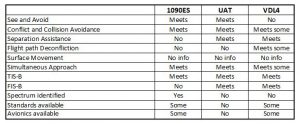
2.10. Ongoing Trials
The TLAT results indicated that further information was required in certain areas, particularly surface movement. Also, further work is continuing to improve the performance of the data links. A number of trials are taking place in many parts of the world. The following list gives an idea of the scope of these trials:
US (Safe Flight 21 programme): Alaskan Region Capstone programme, Ohio River Valley;
Australia: Burnett Basin trial;
Sweden: Arlanda, Kiruna;
Italy: Mediterranean Free Flight programme, Mediterranean Update programme;
Russia: Plans for the Tyumen region and Moscow Airport;
Southern Ring countries: Southern Ring Air Routes Phase II;
Other European: NEAN, NUP II, MA-AFAS, SEAP.
2.11 TIS-B/FIS-B
Two other services associated with ADS-B are Traffic Information Service – Broadcast (TIS-B) and Flight Information Service – Broadcast (FIS-B):
a. TIS is an ATM function that uses a data link to upload radar surveillance data from ground to aircraft. Broadcast TIS (TIS-B) will provide airborne situation awareness of aircraft that are not ADS-B equipped to aircraft that are equipped with ADS-B and a cockpit display. This allows ADS-B equipped aircraft to have visibility of all aircraft traffic in the vicinity (both ADS-B equipped aircraft and non ADS-B equipped aircraft). TIS-B is an important function to deliver benefits from ADS-B in a partially equipped environment and therefore essential for providing supplementary surveillance information during the transition period.
b. FIS is a ground-generated communication function that provides time sensitive weather and supporting information to the aircraft. Although the information can be carried via the point-to-point services, an alternative and more efficient method is to broadcast such information to all users using the broadcast services (FIS-B). Typical FIS-B services include Data Link Operational Terminal Information Services (D-OTIS) and Data Link Runway Visual Range (D-RVR). The D-OTIS service might include sub-services such as Automatic Terminal Information Service (ATIS), Meteorological Aerodrome Report (METAR) and Operational Flight Information Service (OFIS). D-RVR will enable the provision of accurate and instantaneous RVR readouts to the aircrew. FIS-B is also expected to support uplink of weather graphics. The coverage of the FIS-B service can be extended through a ground network allowing, for instance, ATIS for the destination airport to be received early during the flight.
2.12. ADS-B Applications
Work over a period of years has been underway to establish how ADS-B can be applied to the near-term and mid-term future of the ATM system. To this end, EUROCONTROL are taking a phased approach to the application and implementation of ADS-B. The first stage is the development of Package 1, which contains a mixture of airborne and ground surveillance (AS/GS) applications. Package 1 includes applications which have safety, capacity, and efficiency benefits which are relatively less complex to implement than subsequent packages. In order to promote global operational interoperability, joint US and European activities are currently ongoing to align the definition of Package I. An initial comparison with the SF21 packages indicates a considerable similarity, at least with respect the Airborne Surveillance Applications, but further alignment is envisaged to promote maximum interoperability on both sides of the Atlantic.
2.13 EUROCONTROL Package 1
The following table shows the AS/GS applications contained the EUROCONTROL Package 1:
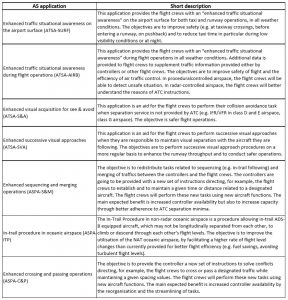
Table 1 – Package 1 Airborne Surveillance Applications
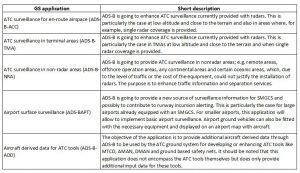
Table 2 – Package 1 Ground Surveillance Applications
2.14. ADS-B/TCAS Relationship
TCAS shares the same frequency bands and uses compatible protocols with Mode S and Extended Squitter. All TCAS-equipped aircraft transmit “acquisition squitters” or “short squitters” on 1090 MHz frequency. These squitters contain the aircraft’s identity and are used by other TCAS equipped aircraft to locate other aircraft in the vicinity. Acquisition squitters do not play a part in ADS-B however the Extended Squitter could be used by ACAS for “Hybrid Surveillance”. This means that the collision avoidance function uses some Extended Squitter information to improve its performance. It is claimed that “Hybrid Surveillance” maintains the independence of ACAS and would significantly reduce the number of ACAS interrogations and therefore reduces the number of transmissions in the 1090 MHz environment (FRUIT). 1090ES is subject to overload which causes FRUIT and has the potential to effect TCAS effectiveness. This only applies when the ADS-B data link is 1090ES and not VDL M4 or UAT.
2.15. ADS-B General Requirements
ICAO and EUROCONTROL have developed general requirements for the surveillance function of ADS-B. The following requirements (Doc 9694 Manual of Air Traffic Services Datalink Applications) provide an indication of what a service provider should meet to achieve before implementing ADS-B:
a. As ADS-B is implemented to different initial levels of capability, with mixed aircraft equipage, ATS providers must ensure efficient levels of service to all airspace users.
b. An ATSU must be capable of knowing that an aircraft is ADS-B equipped.
c. All aircraft operating in an ADS-B airspace will broadcast as required by the ATS provider.
d. The ground system will receive, process and display the ADS-B information.
e. Procedures and/or systems must be in place to validate the ADS-B information.
ATS specific surveillance requirements are as follows:
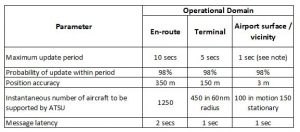
Note: A less frequent update rate may be permissible for stationary emitters.
2.16. Operational Requirements
ATC procedures for the use of ADS-B will be dependent on the phase of flight and the communications infrastructure of the ATS provider. These procedures will be augmented by those contained in PANS-ATM (Doc 4444) and Regional Supplementary Procedures (Doc 7030). It is anticipated that specific ATC procedures will be developed as experience is gained with the systems and as appropriate separation minima are developed for global use. The operational requirements are as follows:
a. The probability exists that errors may be input into the aircraft navigation system prior to departure. Since ADS-B is by definition dependent on the onboard navigation system, procedures will be required to ensure predeparture conformance checking in order to correct these errors.
b. ATS providers should ensure that the number of separation standards applied in a given airspace are kept to a minimum.
c. In a mixed environment, the source of surveillance should be readily apparent to the controller.
d. In a mixed environment, procedures must be in place to ensure that all sources of the display refresh rate will be synchronous, regardless of the source of surveillance information data.
e. The ADS-B application will be capable of providing a warning to pilot and controller whenever the navigation accuracy is degraded below that required to operate in the airspace, as this will affect the application of separation.
f. Back-up procedures should be developed for ADS-B complete and partial system failure.
2.17. Issues to be addressed
The following issues need to be addressed before ADS-B applications can be implemented.
a. Safety Assessment
Before the introduction of any new ATS system or procedure, it is a requirement that a safety assessment be undertaken to identify how safe the system needs to be. This process should identify potential failures and hazards and assess the consequences of their occurrences on the safety of aircraft operations, within a specified operational environment.
b. Use of GPS/GNSS
(See above however included as a separate issue to emphasis the hazard) Although not essential for ADS-B, it is accepted that GPS/GNSS will be the preferred source for both aircraft navigation and surveillance. This raises the issue of a “common cause” failure in that the loss of GPS for whatever reason will impact directly on the aircraft’s ability to navigate and the provision of surveillance.
c. Licensing
The new European licence recognises the introduction of ADS by incorporating a provision for an ADS endorsement under both the Approach Control Surveillance and the Area Control Surveillance ratings. However, the document does not specify any detail about what is required for that endorsement, nor does it clarify the changes to the surveillance rating as opposed the current radar rating.
d. Training
Appropriate training courses will need to be established for controllers.
e. Equipment Certification
ADS-B has 3 elements: airborne equipment, ground equipment, and the communications link between them. The FAA/JAA has addressed the certification of the airborne equipment and is well on the way to establishing requirements however a similar process for the ground equipment has not taken place. This is partly due because national ATM regulators have their own certification procedures consequently harmonisation on a European level has not been developed. This issue does not mean that the implementation of an ADS-B service will be blocked because the proposed service is of a limited nature however the development of requirements should recognise the wider issues such as harmonisation and future ADS-B applications.
f. Operational Procedures
It is acknowledged that the accuracy of ADS-B position reports is greater than either PSR and SSR therefore for comparative purposes, EUROCONTROL have accepted that the performance of ADS-B should be equal to, or better than, SSR. By using this comparison, it is possible to develop operational procedures that can be submitted to the ATS regulator for approval.
g. Legal Liability and responsibility
The AS applications raise legal and liability issues. These are being addressed by IFATCA in the ASAS policy areas.
h. ACAS/ADS-B Interface
The need for TCAS to remain independent is an important cornerstone of IFATCA policy regarding Safety Nets. ADSB with its on-board displays to provide situational awareness to aircrew has the potential to undermine the independence of TCAS.
Conclusions
3.1. ADS-B is regarded in many quarters as the key enabling function for the future ATM system providing safety, capacity, efficiency and cost benefits. To achieve these, ADSB will replace existing surveillance equipment and procedures using both airborne and ground surveillance applications. However, it must be acknowledged that, although considerable work has been completed, there is a long way to go before total implementation. It could be argued that alternative means of surveillance should be retained both as a security and as a contingency measure.
3.2 The implementation of ADS-B applications rises a number of issues for IFATCA particularly in the areas of AS applications and legal liability. Equally, it must be recognised that major benefits can be accrued from many of the GS applications from the provision of enhanced surveillance (with potential separation reductions) in remote and non-radar areas, advanced surface movement guidance systems, and added safety through the provision of data to ATM tools and ground based safety nets.
3.3 The speeding up of ADS-B developments on a global basis requires IFATCA to address the major issues with some urgency and produce policy in the near future.
Recommendations
It is recommended that;
4.1 SC1 should develop policy on ADS-B.
4.2 This paper be accepted as information material.


